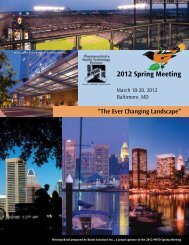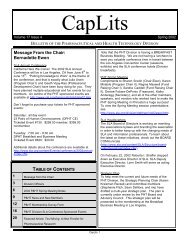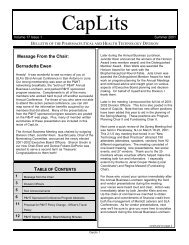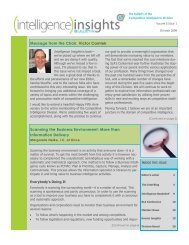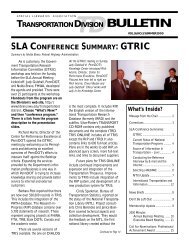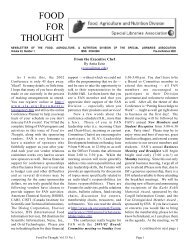Education Libraries - Special Libraries Association
Education Libraries - Special Libraries Association
Education Libraries - Special Libraries Association
You also want an ePaper? Increase the reach of your titles
YUMPU automatically turns print PDFs into web optimized ePapers that Google loves.
Highlights of chapter one include the birth of modern<br />
soccer through establishment of original rules in 1863,<br />
and the 1904 formation of FIFA, the governing body of<br />
the sport. The World Cup began play in 1930. The<br />
format called for teams to be placed into group brackets.<br />
Teams possessing the best records after group play<br />
advanced to the semifinal games, with the remaining two<br />
teams squaring off for the championship.<br />
In chapters three through five, Lisi focuses on Brazil’s<br />
World Cup success. A perennial contender for the World<br />
Cup, Brazil has taken part in all 18 tournaments,<br />
winning five.<br />
Pelé, the great Brazilian star known as “The God of<br />
Football” is profiled. After playing on four Brazilian<br />
World Cup teams, Pelé helped to popularize the sport in<br />
the United States by joining the New York Cosmos of<br />
the now defunct North American Soccer League during<br />
the mid-1970s. English star David Beckham had a<br />
similar effect when he signed with the Los Angeles<br />
Galaxy of Major League Soccer in 2007.<br />
Chapter seven considers whether soccer has gained<br />
greater acceptance in the United States after the 1994<br />
World Cup. By awarding the games to the United States<br />
for the first time, FIFA hoped to foster an appreciation<br />
for the sport. Soccer festivals were held throughout the<br />
country to promote the World Cup. Group play took<br />
place in nine different cities. Over 94,000 spectators<br />
witnessed the final match in the Rose Bowl, while over<br />
one billion fans watched the television broadcast of<br />
Brazil’s victory.<br />
Chapter eight contains pictures of the infamous headbutt<br />
by the temperamental French midfielder Zidane.<br />
Lisi notes that the vicious incident in the 2006<br />
championship game is the first use of instant replay by<br />
an official. Zidane was ejected from the contest as Italy<br />
captured its fourth World Cup. Zidane ended his career<br />
in shame, although he later claimed that the Italian<br />
defender Materrazi taunted him with profane comments<br />
about Zidane’s mother and sister.<br />
The book concludes with the glossary, appendices of<br />
yearly statistics and historical records, bibliography, and<br />
index.<br />
A History of the World Cup: 1930-2006 is a<br />
comprehensively researched source that will benefit<br />
newcomers to the sport as well as veteran observers of<br />
the tournament. Lisi’s enthusiasm for soccer can be<br />
easily ascertained. With the World Cup’s growing<br />
popularity in the United States, this text will be a very<br />
useful addition to the reference collection of any high<br />
school, public, or academic library.<br />
Warren Jacobs is a Reference/Instruction Librarian at<br />
California State University, Stanislaus. Email:<br />
wjacobs@csustan.edu<br />
A to Z of the<br />
Olympic<br />
Movement—<br />
Reviewed by<br />
Warren Jacobs<br />
Mallon, Bill, with<br />
Buchanan, Ian. The<br />
A to Z of the<br />
Olympic Movement.<br />
Lanham, MD:<br />
Scarecrow Press,<br />
2007. ISBN 978-0-<br />
8108-5645-5.<br />
$40.00.<br />
The Olympic movement demonstrates the power of sport<br />
to enrich mankind through friendly athletic competition<br />
every four years. The former television host of the<br />
Olympics, Jim McKay, once called the games, “the<br />
largest peacetime gathering of humanity in the history of<br />
the world.” Idyllic at times, the Olympic Games are not<br />
immune from political, economic, and sociological<br />
pressures afflicting the world.<br />
Bill Mallon and Ian Buchanan are founding members of<br />
the International Society of Olympic Historians. In 1995,<br />
they wrote Historical Dictionary of the Olympic<br />
Movement to present a complete reference volume<br />
covering not only the superlative athletic feats, but the<br />
history, politics, and personalities of the Olympics. This<br />
title is the third edition of their original dictionary. The<br />
authors have also collaborated on several other titles on<br />
this subject, and were honored for their scholarly<br />
contributions to the Olympic movement.<br />
The first part of the text furnishes definitions for many<br />
three-letter acronyms and abbreviations representing<br />
sports contested, Olympic nations, and governing bodies<br />
of sport. The next section contains a brief chronology of<br />
the Olympic movement listing important events from the<br />
12 th century BCE through the upcoming Winter Games<br />
of 2010. Detailed summaries are provided for the<br />
<strong>Education</strong> <strong>Libraries</strong>, Volume 31, No. 2, Winter 2008 58




